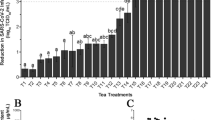Abstract
The aim of the study was to assess the activities of six plant infusions against Helicobacter pylori strains using a comparative screening assay (CSA), agar-well diffusion method (AWDM) and microscopy. Green tea, St John’s wort (SJW), rooibos, peppermint, chamomile and lime flower aqueous infusion concentrations were chosen to mimic those in herbal teas/tisanes. CSA concentrations were 4.5 mg ml−1 for chamomile and 6.8 mg ml−1 for the other agents. AWDM amounts were 0.4 mg/well for the chamomile and 0.6 mg/well for the other agents. Using CSA, ≥8 × 104 colony forming unit reduction was found in >60 % of the strains by the green tea (81.5 %), SJW (75.9 %) and rooibos (63.0 %) within 2 h. Similarly, by AWDM, the activity against >60 % of the strains was found by the green tea, SJW and rooibos. Gram staining results were alike, showing mostly/only coccoids in >66 % of the strains by the same three agents within 2 h. Lime flowers showed the lowest activity by all methods. In conclusion, CSA allows comparing the activities of many agents against numerous strains. To our knowledge, these are the first data about rooibos and lime flower activities against H. pylori. All the three methods revealed that the most active agents were the green tea, SJW and rooibos, which also possess additional beneficial properties, e.g. antioxidant, anti-inflammatory and antitumor effects, therefore these plants may have a beneficial use as prophylactic agents against or adjuvants in the therapy of H. pylori infection.
Similar content being viewed by others
References
Akdogan M, Ozguner M, Aydin G, Gokalp O (2004) Investigation of biochemical and histopathological effects of Mentha piperita Labiatae and Mentha spicata Labiatae on liver tissue in rats. Hum Exp Toxicol 23:21–28. doi:10.1191/0960327104ht412oa
Boyanova L (2011) Non-antibiotic agents in the treatment of H. pylori infection. In: Boyanova L (ed) Helicobacter pylori. Caister Academic Press, Norfolk, pp 253–275
Boyanova L, Gergova G, Nikolov R, Davidkov L, Kamburov V, Jelev C, Mitov I (2008) Prevalence and evolution of Helicobacter pylori resistance to 6 antibacterial agents over 12 years and correlation between susceptibility testing methods. Diagn Microbiol Infect Dis 60:409–415. doi:10.1016/j.diagmicrobio.2007.11.008
Castillo-Juárez I, González V, Jaime-Aguilar H, Martínez G, Linares E, Bye R, Romero I (2009) Anti-Helicobacter pylori activity of plants used in Mexican traditional medicine for gastrointestinal disorders. J Ethnopharmacol 122:402-405. http://dx.doi.org/10.1016/j.jep.2008.12.021
Imazato S, Ohmori K, Russell RR, McCabe JF, Momoi Y, Maeda N (2008). Determination of bactericidal activity of antibacterial monomer MDPB by a viability staining method. Dent Mater J 27:145-158. http://dx.doi.org/10.4012/dmj.27.145
Joubert E, Winterton P, Britz TJ, Gelderblom WC (2005) Antioxidant and pro-oxidant activities of aqueous extracts and crude polyphenolic fractions of rooibos (Aspalathus linearis). J Agric Food Chem 53:10260–10267. doi:10.1021/jf051355a
Mahady GB, Pendland SL, Stoia A, Hamill FA, Fabricant D, Dietz BM, Chadwick LR (2005) In vitro susceptibility of Helicobacter pylori to botanical extracts used traditionally for the treatment of gastrointestinal disorders. Phytother Res 19:988–991. doi:10.1002/ptr.1776
Mizuno S, Kato K, Ono Y, Yano K, Kurosaka H, Takahashi A, Abeta H, Kushiro T, Miyamoto S, Kurihara R, Hiki N, Kaminishi M, Iwasaki A, Arakawa Y (2006) Oral peppermint oil is a useful antispasmodic for double-contrast barium meal examination. Gastroenterol Hepatol 21:1297–1301. doi:10.1111/j.1440-1746.2006.04131.x
Orčić DZ, Mimica-Dukić NM, Francišković MM, Petrović SS, Jovin ED (2011) Antioxidant activity relationship of phenolic compounds in Hypericum perforatum L. Chem Cent J 5:34. doi:10.1186/1752-153X-5-34
Reichling J, Weseler A, Saller R (2001) A current review of the antimicrobial activity of Hypericum perforatum L. Pharmacopsychiatry 34(Suppl 1):S116–S118. doi:10.1055/s-2001-15514
Rodriguez-Fragoso L, Reyes-Esparza J, Burchiel SW, Herrera-Ruiz D, Torres E (2008) Risks and benefits of commonly used herbal medicines in Mexico. Toxicol Appl Pharmacol 227:125–135. doi:10.1016/j.taap.2007.10.005
Saddiqe Z, Naeem I, Maimoona A (2010) A review of the antibacterial activity of Hypericum perforatum L. J Ethnopharmacol 131:511–521. doi:10.1016/j.jep.2010.07.034
Shikov AN, Pozharitskaya ON, Makarov VG, Kvetnaya AS (2008) Antibacterial activity of Chamomilla recutita oil extract against Helicobacter pylori. Phytother Res 22:252–253. doi:10.1002/ptr.2243
Simpson MJ, Hjelmqvist D, López-Alarcón C, Karamehmedovic N, Minehan TG, Yepremyan A, Salehani B, Lissi E, Joubert E, Udekwu KI, Alarcon EI (2013) Anti-peroxyl radical quality and antibacterial properties of rooibos infusions and their pure glycosylated polyphenolic constituents. Molecules 18:11264–11280. doi:10.3390/molecules180911264
Szoke E, Máday E, Tyihák E, Kuzovkina IN, Lemberkovics E (2004) New terpenoids in cultivated and wild chamomile (in vivo and in vitro). J Chromatogr B Analyt Technol Biomed Life Sci 800:231-238. http://dx.doi.org/10.1016/j.jchromb.2003.09.038
Weseler A, Geiss HK, Saller R, Reichling J (2005) A novel colorimetric broth microdilution method to determine the minimum inhibitory concentration (MIC) of antibiotics and essential oils against Helicobacter pylori. Pharmazie 60:498–502
Yanagawa Y, Yamamoto Y, Hara Y, Shimamura T (2003) A combination effect of epigallocatechin gallate, a major compound of green tea catechins, with antibiotics on Helicobacter pylori growth in vitro. Curr Microbiol 47:244–249. doi:10.1007/s00284-002-3956-6
Yeşilada E, Gürbüz I, Shibata H (1999) Screening of Turkish anti-ulcerogenic folk remedies for anti-Helicobacter pylori activity. J Ethnopharmacol 66:289–293. doi:10.1016/S0378-8741(98)00219-0
Acknowledgments
This study was supported by Grant No 34/2012 of the Medical University-Sofia (Council of Medical Science). I thank Prof. Ivan Mitov and Dr. Galina Gergova of the Department of medical microbiology, Medical University-Sofia for their assistance. The author has no conflict of interest to declare.
Author information
Authors and Affiliations
Corresponding author
Rights and permissions
About this article
Cite this article
Boyanova, L. Comparative evaluation of the activity of plant infusions against Helicobacter pylori strains by three methods. World J Microbiol Biotechnol 30, 1633–1637 (2014). https://doi.org/10.1007/s11274-013-1589-5
Received:
Accepted:
Published:
Issue Date:
DOI: https://doi.org/10.1007/s11274-013-1589-5




